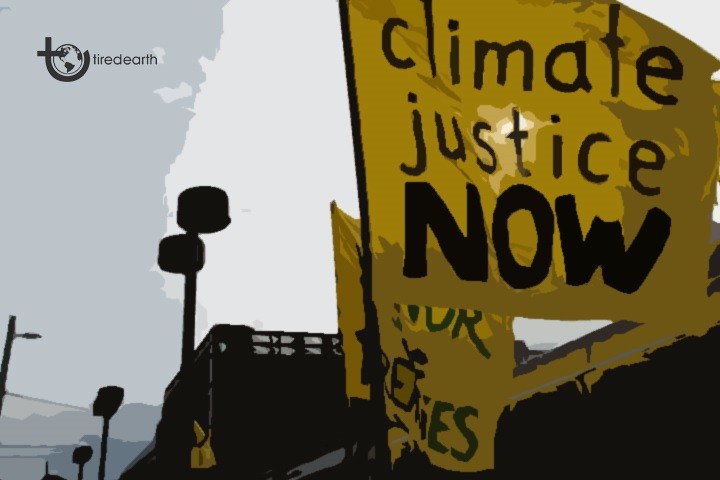Historical construction of climate justice

Nature is transversal and intrinsic to the way we live. There is no human being if nature does not exist. However, this awareness has been dampened so as not to be part of the construction of what historians call civilization. The world's development model has always been against the preservation of natural resources, using them as infinite goods. And it was only in the mid-1900s that a green movement began to appear timidly, reinforcing through treaties and studies what our ancestors have always told us.
Therefore, if we analyze the chronological time the collective consciousness about the environment, sustainability, climate change, climate justice have been gaining strength over the years, bursting the bubble gradually, making people from various sectors and social strata begin to understand the relevance of the issue.
The dates below the timeline are intended to show the historical evolution until reaching climate justice, in addition to fostering the perception that we are walking and evolving in strengthening the agenda. We are not at the ideal pace for an effective confrontation of the climate crisis, but analyzing the historical evolution brings the perception that we are moving forward as a society.
1948
The Universal Declaration of Human Rights emphasizes in Article 25 that everyone has the right to a standard of living adequate for his or her well-being.
1972
The 1972 Stockholm Declaration on the Human Environment. It was the first international environmental agreement, stressing the importance of environmental protection and adequate living conditions.
1987
Brundtland Report in 1987. The idea of sustainable development was presented by the World Commission on Environment and Development (WCED) in the report "Our Common Future", also known as the Brundtland Report.
1988
Created the IPCC - Intergovernmental Panel on Climate Dances where an initial idea of climate justice enters into WG2 of vulnerability and negative effects on ecosystems and people.
1992
United Nations Conference on Environment and Development - Rio 92 - ECO 92 - Earth Summit. The United Nations Framework Convention on Climate Change (UNFCC) is in Article 3 on responsibility, however differentiated.
2000
In 2000, in parallel to the Sixth Conference of the Parties (COP 6), the first Climate Justice Summit was held in The Hague. The summit aimed to "affirm that climate change is a rule of law" and to "build alliances between states and borders" against climate change and in favor of sustainable development.
2001
Climate Justice is part of the Intergovernmental Panel on Climate Change (IPCC).
2002
In August, international environmental groups gathered in Johannesburg for the Earth Summit, also known as Rio + 10, because it took place ten years after the 1992 Earth Summit. The Bali Climate Justice Principles were adopted:
"Climate Justice affirms the rights of communities that depend on natural resources for their livelihoods and cultures to own and manage them in sustainable management, and opposes the commodification of nature and its resources."
2005
Inuit Circumpolar Conference (a multinational non-governmental organization and indigenous peoples' organization representing the 180,000 Inuit, Yupik and Chukchi peoples living in Alaska, Canada, Greenland and Chukotka).
The moment in history when human rights and climate change were linked: the pre-party to the Inuit Circumpolar Conference submitted a petition to the Inter-American Commission on Human Rights (IACHR) "seeking relief for human rights violations resulting from the impacts of global warming and climate change" and saying that the United States "violated the human rights of the Inuit by failing to adopt greenhouse gas (GHG) controls."
2007
Malé Declaration on the Human Dimension of Global Climate Change. The Small Island Developing States (SIDS) have adopted the Malé Declaration on the Human Dimension of Global Climate Change, the first international agreement recognizing that climate change is a real threat to the full enjoyment of human rights.
2010
COP16 - Cancun - Cancun Adaptation Framework. REDD+ (Reducing Emissions from Deforestation and Forest Degradation) "raises important issues of fairness, bringing equity in decision making to guide that REDD+ finance is distributed equitably, benefiting the most vulnerable. There is also concern for indigenous and local communities. The Cancun Agreement states that both should have effective participation in decision-making and that their knowledge and rights should be respected in all REDD+ processes.
2012
COP18 Doha - Qatar - Decision on loss and damage. The possibility of creating international insurance to address potential losses suffered by poor countries affected by climate change is established.
2013
Warsaw COP - Warsaw Mechanism on Loss and Damage. Central countries are asked to continue to mobilize public money, at levels higher than the emergency aid decided for 2010-2012 of US$ 10 billion per year. In addition, the first capitalization of the Climate Fund must reach a very significant level, reflecting the fundamentalities and challenges it must overcome to address climate change.
2015
COP21- rectification of the Paris Agreement
Agenda 2030- The cross-cutting nature of the ecological crisis and climate emergency is highlighted in the 17 Goals, specifically in Goal 13, Climate Action.
2017
A report by the United Nations Environment Program identified 894 ongoing climate justice lawsuits around the world. Today we have about 1,500 worldwide.
2018 - 2021
The children and youth climate movement is starting to spread around the world! Fridays for Future
2022
IPCC Report 2022: Impact, Adaptation and Vulnerability. Working Group II's contribution to the IPCC's Sixth Assessment Report was on the impacts of climate change, analyzing ecosystems, biodiversity and human communities at the global and regional levels. It also analyzes the vulnerabilities, capacities and limits of the natural world and human societies to adapt to climate change.
Climate impacts can exacerbate unequal and unfair social conditions.

